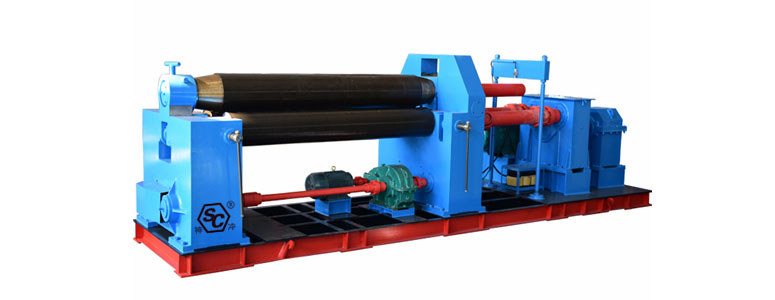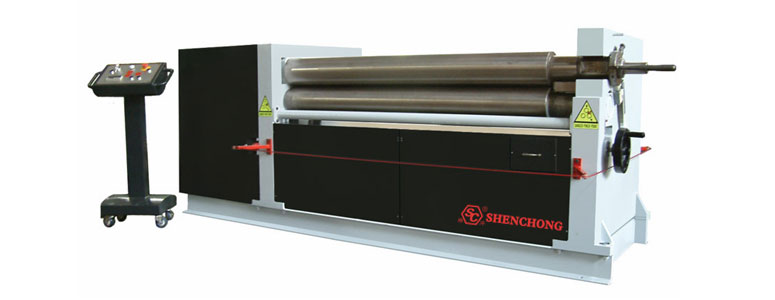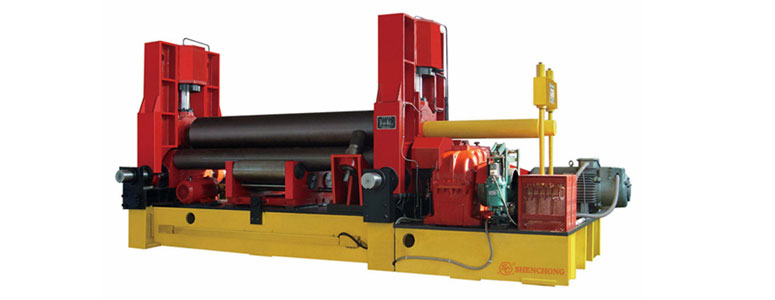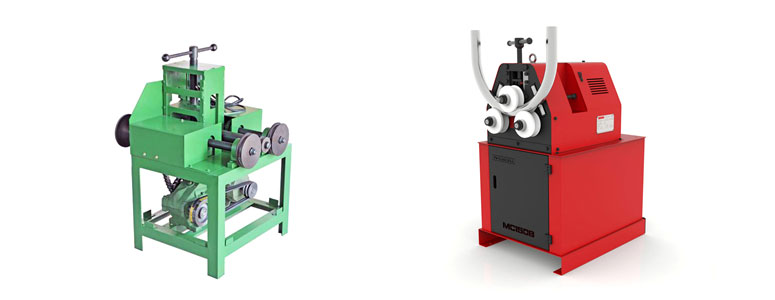
The roll bending machine is a kind of equipment which work rollers to bend the sheet metal. It can form sheet metal to be different shapes, such as oval, arc, and cylindrical workpiece. It is very important processing equipment.
The working principle of the plate bending machine is to move the work roll through the action of hydraulic pressure, mechanical force and other external forces, so as to make the plate bend or roll into shape.
Because of different work fields, roll bending machines are also different. From the roller numbers, can be divided into three-roller and four-roller.
The three-roller is divided into symmetrical three-roller type, horizontal downward-adjusting type, arc-downward-adjusting type, upper-roller universal three-roller type, and hydraulic CNC bending machine.
From the transmission, it is divided into mechanical type and hydraulic type.
– Mechanical three-roller symmetry

Performance characteristics of mechanical three-roller symmetrical plate bending machine:
- The structure of the machine is three-roller symmetrical.
- The upper roller moves vertically at the central symmetrical position of the two lower rollers.
- Rotational motion, through the output gear of the reducer meshing with the lower roller gear, provides torque for the rolled plate.
- The disadvantage of this machine is that the end of the plate needs to be pre-bent with the help of other equipment.
– Mechanical three-roll asymmetrical

The main features of the mechanical three-roll asymmetrical plate bending machine:
- The structure of the machine is a three-roll asymmetrical type, the upper roller is the main drive, the lower roller moves vertically to clamp the plate, through the lower roller gear meshing with the upper roller gear, also as the main drive at the same time.
- The side rollers are tilted and lifted, with the dual functions of pre-bending and rolling. Compact structure, convenient operation and maintenance.

The main features of the hydraulic three-roller symmetrical plate bending machine:
- The upper roller of the machine can be vertically raised and lowered, and the vertical lifting, which is obtained by the hydraulic oil in the hydraulic cylinder acting on the piston rod; the lower roller is driven in rotation, and the output gear of the reducer is meshed.
- Provide torque for the coil, and there is a supporting roller under the lower roller, which can be adjusted.
- The upper roller is in the shape of a drum, which improves the straightness of the product, and is suitable for ultra-long tanks with various cross-sectional shapes.
- The up-adjusting symmetrical three-roller plate rolling machine can roll metal plates into circular, arc-shaped and conical workpieces.
- The two lower rollers of this model are the driving rollers, the upper roller is the driven roller.
- It is widely used in shipbuilding, boiler, aviation, hydropower, chemical, metal structure and machinery manufacturing industries.
It is suitable for bending and deformation of metal plates. It can roll round, arc and tapered workpieces, and has the function of pre-bending the end of the plate. The two lower rollers of this model are driving rollers which can move horizontally. The top roller is driven roller which can move up and down. There are mechanical and hydraulic movement modes. The drive shafts are all connected by universal couplings.

Pipe bender machine can be divided into CNC pipe benders, hydraulic pipe bender and so on.
Mainly used for electric power construction, highway and railway construction, boilers, bridges, ships, furniture, decoration and other aspects of pipeline laying and repairing.
It has the advantages of multiple functions, reasonable structure, and simple operation.
The pipe bending machine performs the bending of the pipe and sheet metal.
When bending, the tube with an outer diameter of D, the wall thickness of t, is bent under the action of an external moment M, the outer tube wall of the neutral layer is subjected to tensile stress σ1, and the tube wall becomes thinner; the inner tube of the neutral layer. The wall is subjected to tensile stress σ1, and the pipe wall becomes thicker.
Moreover, due to the combined forces F1 and F2, the cross-sectional shape changes from a circular shape to an approximately elliptical shape. When the deformation is too large, cracks will occur on the outer tube wall, wrinkles on the inner tube wall.
The pipe bender machine bending limitation include the following points:
- The maximum elongation deformation in the neutral layer outside tensile deformation zone, which does not exceed the allowable value of the material’s plasticity.
- The compression deformation zone inside the neutral layer, the part of the thin-walled structure under the action of tangential compressive stress will not exceed the instability and wrinkle.
- If the ellipticity of the pipe is required, we need make attention on the the distortion of the section.
- If the pipe has a strength requirement to withstand internal pressure, we need control the forming limit of its wall thickness reduction.